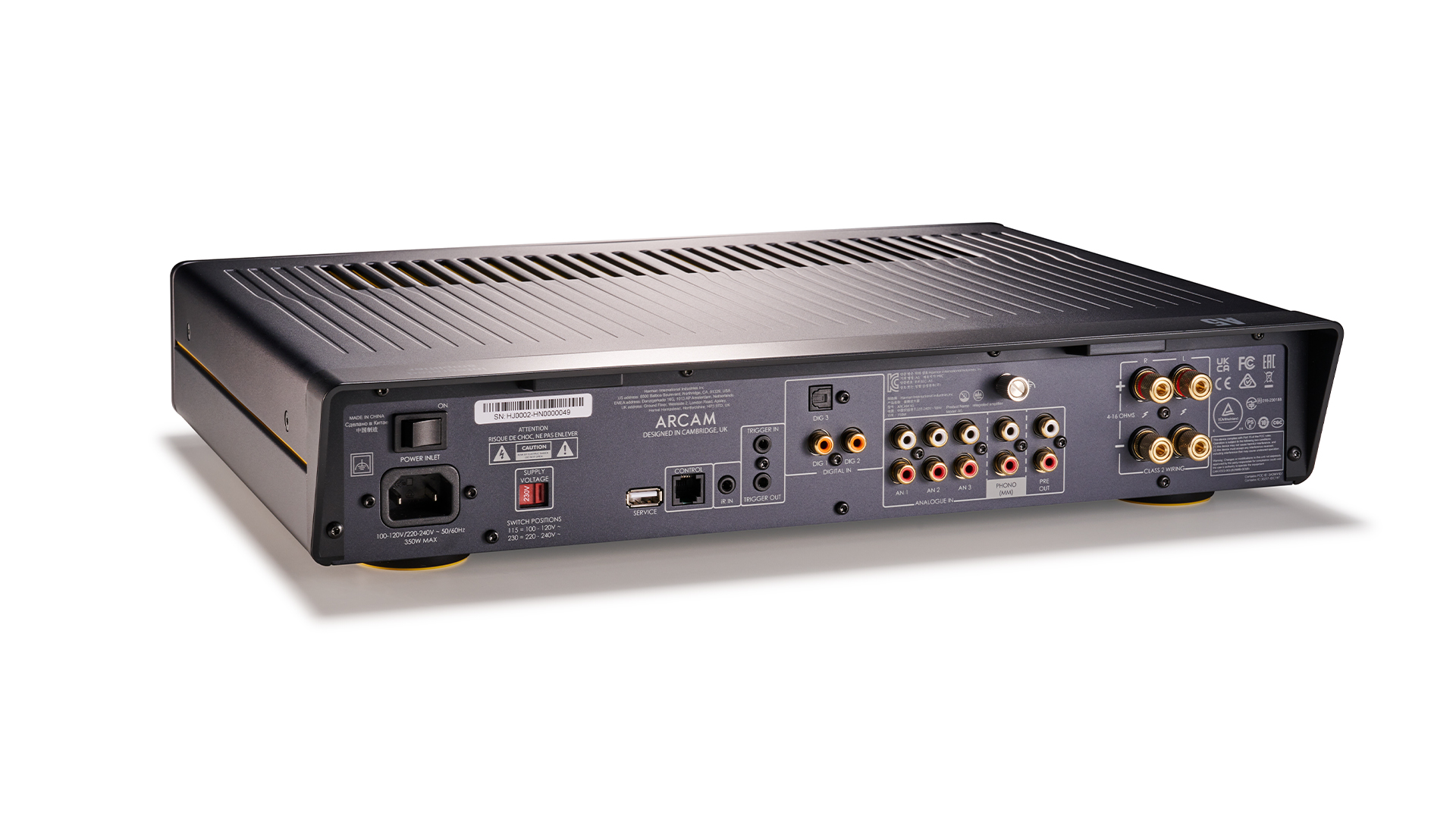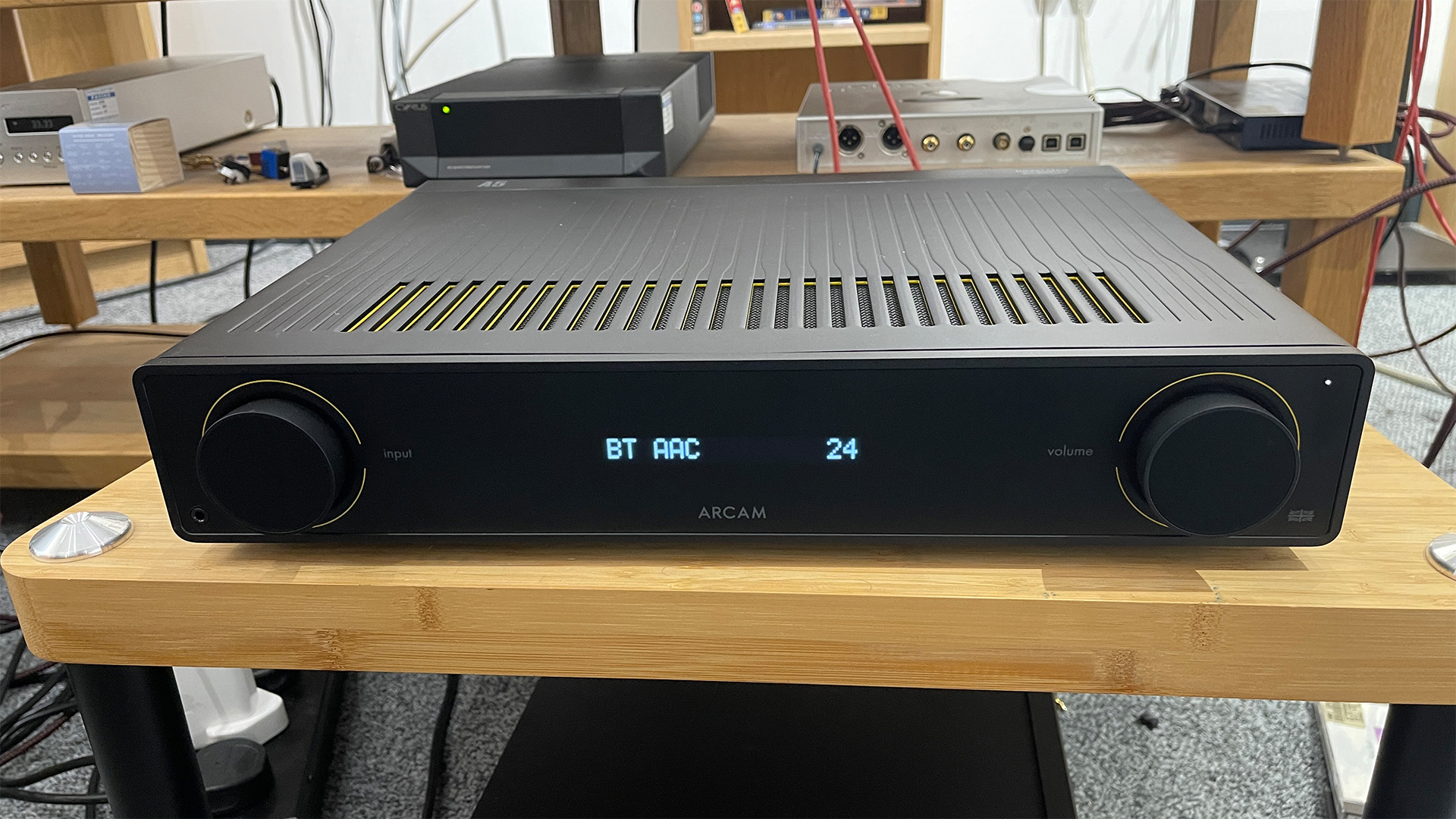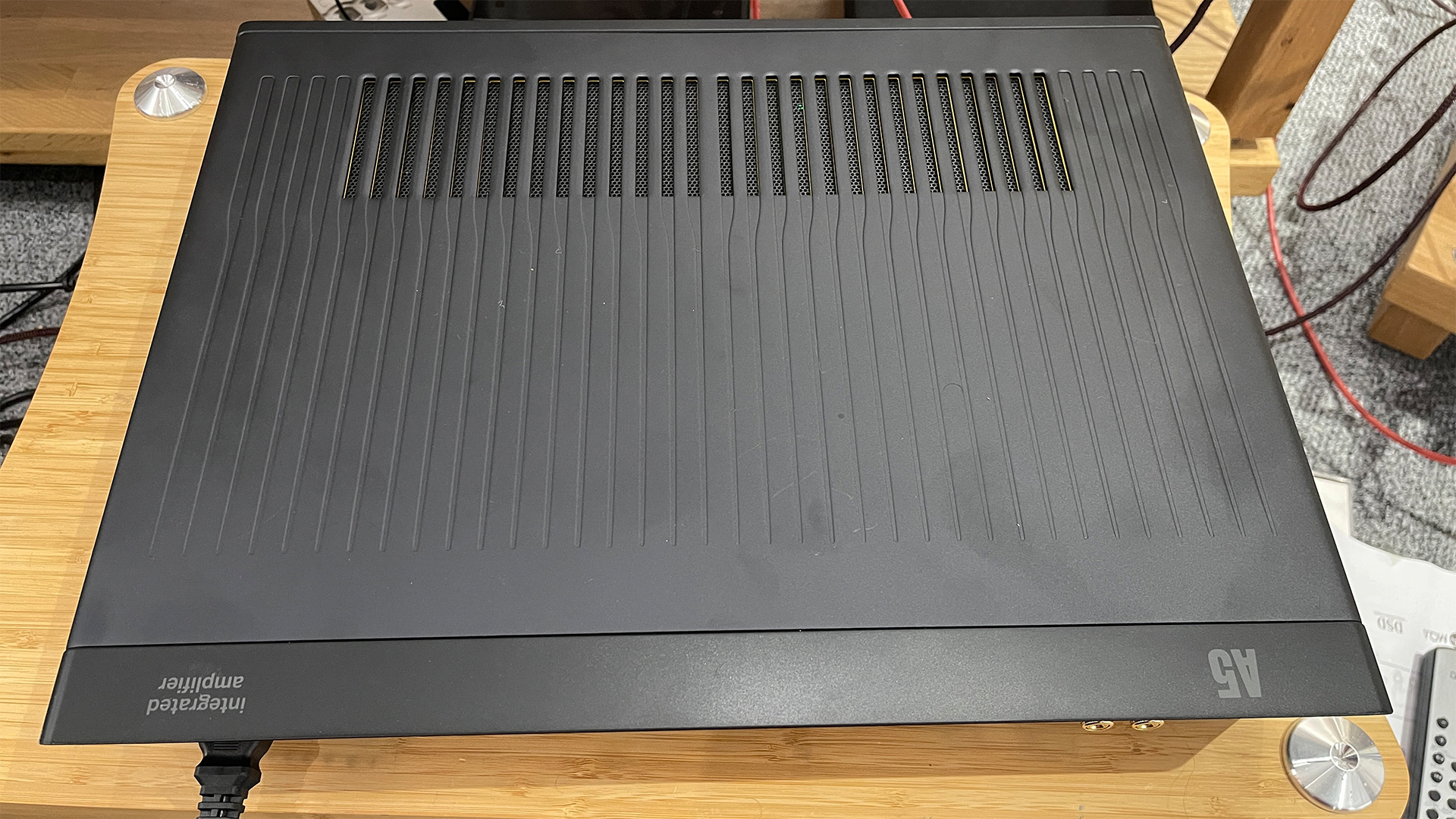What Hi-Fi? Verdict
Arcam is back in the stereo amplifier market with a bang. The A5 is good enough to scare the current class leaders.
Pros
- +
Impressively insightful, articulate and entertaining presentation
- +
Unfussy nature
- +
Strong feature list
- +
Fine build
Cons
- -
‘Frosted’ front means the display lacks crispness
- -
No USB input
Why you can trust What Hi-Fi?
Amplification is at the very core of what Arcam has always done. The company’s first product, the hugely successful A60 integrated amplifier introduced in 1976, laid the foundations for the brand to grow into the diverse company it is today.
It is also fair to say that in recent decades the company’s focus seemed to be concentrated on the home cinema side of things where it has become known for producing some of the most musical premium AV amplifiers on the market. Make no mistake, there have been some fine stereo products in that time – the Award-winning A19 integrated amplifier, the compact rPhono and numerous generations of rDAC come to mind – but Arcam’s once dominant presence in the affordable stereo component market had definitely waned, leaving the likes of Cambridge Audio, Marantz and Rega to take bigger pieces of the pie. Things may be about to change with the introduction of the brand-new Radia range of products. This consists of three stereo amplifiers: the A5 on test here, A15 (£1099 / $999) and range-topping Class G A25 (£1499 / $1499), the CD5 player (£699 / $699) and ST5 music streamer (£799 / $799).
Build & Design

We can’t think of a better place to start than the entry-level A5 amplifier. It is the most affordable amplifier in the range yet perfectly encapsulates what the company is trying to do. There is the way it looks for starters. To our eyes, this is a fresh and modern-looking product. We like its clean and unfussy exterior which looks simple yet elegant. The subtle yellow highlights around the large control dials, vents and sides may not come across with much impact in the photos, but in the metal, they give the amplifier a sleek appearance that sets it apart from price rivals.
This is a nicely built product with a sturdy aluminium case and smart finish. The two front panel control dials are nicely weighted and spin smoothly. We’re less taken with the front panel display. It is decently large and easy to read but the frosted finish robs the display of crispness. Still, the set-up menus are easy to navigate, and while the supplied remote handset isn’t the most luxurious feeling wand around, it is, at least, simple to use and small enough to comfortably fit into most hands.
Features

This amplifier is more than just a pretty face. The company has obviously thought long and hard about the features to include and has come up with what is arguably the most comprehensively equipped stereo amplifier we’ve reviewed at this level. On the analogue side of things, there are three line-level inputs plus a moving magnet phono stage. Those who feel the A5’s 50 watts per channel output won’t be enough can add an outboard power amplifier courtesy of the Arcam’s preamplifier outputs. If digital is your thing then you have a pair of coaxial inputs and a single optical input, all capable of accepting music streams of up to 24-bit/192kHz thanks to an ESS ES9018 DAC chip. It would have been nice to have the option of USB, but we don’t think the lack of it is a deal breaker.

Type Integrated
Power 50W per channel
Phono stage Moving magnet
Inputs Line level x3, optical, coax x2
Outputs Pre-out
Bluetooth aptX Adaptive (two-way)
Headphone output? Yes (3.5mm)
Dimensions (hwd) 8.3 x 43.1 x 34.4cm
Weight 8 kg
Bluetooth 5.2 with aptX Adaptive is on the menu, but there is a bonus in the implementation as it not only allows the A5 integrated to accept a signal but also lets it send the sound out to a Bluetooth-enabled speaker or headphones. Neat.
We try the A5 in our reference system of Naim ND555/555 PS DR and ATC SCM50 speakers as well as with more price-compatible products such as the Cyrus CDi CD player, the Cambridge Audio CXN (V2) music streamer and both the PMC Prodigy 5 and KEF LS50 Meta speakers. Despite the relatively modest claimed power output, this Class A/B amplifier has no trouble driving any of the speakers to decent levels in our relatively large listening room (3 x 7 x 5m, hwd).
Sound

An amplifier at this level has a difficult balancing act to perform. It is as likely to be partnered with budget kit as it is more premium offerings, so it has to be forgiving enough not to emphasise the shortcomings of more limited partnering equipment, yet still have the insight and transparency to make the most of more capable signals. The A5 manages this balancing act superbly. It has a sweet nature that while full-bodied and smooth never errs far enough to rob the life from the music.
We start with the analogue line-level inputs and listen to Eminem’s Recovery set – a thin, rather hard-sounding recording – and the Arcam treads the line between diplomacy and bluntness brilliantly. It has a refined yet lively presentation that conveys the building momentum of a track like No Love superbly, thanks to a confident and surefooted way with rhythms. We like the midrange too. It is clear, articulate and full-bodied. Eminem comes through with venomous attitude intact and we have no trouble tracking every word of his rapid-fire delivery.
There is a fine sense of control too, with the amplifier showing impressive composure when the music gets demanding. It doesn’t sound stressed or cluttered, even when pushed to higher volume levels. Lows are well-defined and authoritative but pleasingly agile with it. There is plenty of punch too, which keeps things entertaining.
We switch to Mahler’s Tenth Symphony and the A5 doesn’t flinch. It delivers a good sense of scale here and has the resolution to keep track of a multitude of instrumental strands without sounding confused. The A5’s full-bodied tonality works well here, giving the orchestra a pleasing amount of solidity and presence. We have no complaints about the stereo imaging either, with the Arcam delivering an expansive soundstage populated with sharply focussed instruments. It is nicely layered too, giving a fine impression of depth to the presentation. Larger scale dynamic swings are rendered with conviction and there is a good dose of scale on show too.

We switch to the phono input with some trepidation. We have our reference Technics SL-1000R/Vertere Sabre record player as the source but are braced for disappointment. Why? Most manufacturers at this level treat the phono stage as a box-ticking exercise and don’t really take much care in the way it sounds. As things turn out, we needn’t have worried. The moving magnet phono module in the A5 is a good one. It sounds clear and expressive, delivering Mary J Blige’s No Drama set with all the passion intact. There is a good level of resolution here and the noise levels are low. All in all, it retains the entertaining character of the line stages and we can’t ask for much more than that.
Arcam has a great deal of experience with digital-to-analogue converters. In fact, it was one of the pioneers of dedicated outboard units back in the 1980s. That experience shines through in the A5’s DAC section. There is a choice of three digital filters, each offering a slightly different flavour. There isn’t a right or wrong answer here, but we tend to prefer Filter 2 in our set-up.

Regardless of the filter option chosen, the Arcam’s digital section sounds crisp and punchy, maybe losing just a little of the warmth of the line stages but still delivering plenty in the way of insight. It is certainly a useful addition to the amplifier’s armoury and will give most budget DACs a run for their money in most respects.
It is a similarly positive story with the headphone output. This is specified to work with loads of between 16 ohms and 2 kOhms and doesn’t have an issue driving any of the cans we try. These include the Grados SR325x and Sony’s MDR-Z1R headphones.
Bluetooth pairing is swift and the performance is good for this connection. It is never going to match any of the wired alternatives for outright quality but remains a good convenience option. The A5 works well as the receiver of the signal and also performs well enough as the source feeding a separate wireless headphone, we use Sony’s WH-1000XM5 without issue.
Verdict

As we switch between sources we cover a wide range of music in our time with the Arcam A5, and it never disappoints. This is a superbly rounded performer that simply gets on with the job of playing music without intruding on the experience. Partner it with suitably capable sources and speakers, and it will invariably deliver musical and enjoyable results. It has been many years since we’ve heard such a convincing stereo amplifier from Arcam. If you are thinking of buying at this level, this one has to go at the top of your shortlist. It really is that good. Welcome back Arcam.
Review published: 2023. Review updated: November 2024.
SCORES
- Sound 5
- Build 5
- Features 5
MORE:
Read our Arcam A15 review
Also consider the Cambridge Audio CXA61
Read our Cambridge Audio CXA81 review
Best stereo amplifiers: the best integrated amps you can buy
What Hi-Fi?, founded in 1976, is the world's leading independent guide to buying and owning hi-fi and home entertainment products. Our comprehensive tests help you buy the very best for your money, with our advice sections giving you step-by-step information on how to get even more from your music and movies. Everything is tested by our dedicated team of in-house reviewers in our custom-built test rooms in London, Reading and Bath. Our coveted five-star rating and Awards are recognised all over the world as the ultimate seal of approval, so you can buy with absolute confidence.
-
podknocker CD5 £699Reply
ST5 £799
A5 £749
A15 £1099
A25 £1499
Nearly £2500 with the cables and then you need speakers.
I think this is a lot for an entry level starter system.
Again, the first 2 units combined as one, for £749?
Then the £749 again for the cheapest 50WPC amp.
A more powerful amp at twice the power might be useful.
I don't think Arcam need 3 amps in this range. -
jetblack9090 Reply
I don't know I don't think that's necessarily the way I see it, I mean I think they introduced the models they have at various price points to appeal to different tastes and ultimately to different markets. What Hi-Fi has demonstrated through their initial review that both the A-5 and the A-15 are capable performers and truly you couldn't go wrong with either. Personally I'm not really into CDs, so buying the CD player wouldn't necessarily be on my want list, conversely I don't really stream although when I do I already have a capable streamer.podknocker said:CD5 £699
ST5 £799
A5 £749
A15 £1099
A25 £1499
Nearly £2500 with the cables and then you need speakers.
I think this is a lot for an entry level starter system.
Again, the first 2 units combined as one, for £749?
Then the £749 again for the cheapest 50WPC amp.
A more powerful amp at twice the power might be useful.
I don't think Arcam need 3 amps in this range.
My biggest thing I like about the new range is the fact that the amplifier use two-way Bluetooth. So few amplifiers, at least hi-fi amplifiers use two-way, matter of fact NAD is the only company that I can think of that actually has implemented this type of design. And I know it sounds silly, I mean I have a nice system already but I like the versatility of the idea. Like I don't have to worry about plugging wired headphones in to listen to music I can just use my Google buds that I already have for late night listening and more personal listening sessions. And like I said to me that is the biggest advantage and one of the key features of the new amps to me.
Plus I've always found I enjoy the sound of arcam products. I've had basically every amp of the alpha series as well as I've tried the newer FMJ series which was fantastic and I've listened to but haven't personally owned the newer SA series.
I mean I'm in the US so value for dollar between the British pound and the usd doesn't always translate very well, Rega case in point, that said though I think for the 699 that they're asking in US dollars is not bad considering the pedigree and versatility and ultimate value that the A5 represents. I know as soon as one is available for me to buy I'm going to buy it, I've been needing to pick up a replacement amp for a office type system for a while after my old sansui went kaput. -
Guy4510 Interesting product but no HDMI connection is a big negative for me, and I'm sure others who want the most elegant connection to their TV?! Surprised infact that What Hi-Fi has given this model and it's bigger sibling 5 stars for features with this imo rather large omission..Reply -
jetblack9090 Reply
Is it really that big of an omission?, I mean it does have optical or tosink as I believe you guys are want to say. Personally I don't hook my TV to my stereo system so I don't see it as being an issue, matter of fact I know a lot of people that do not do that, and while I see an HDMI input as advantageous I don't see it as a necessity.Guy4510 said:Interesting product but no HDMI connection is a big negative for me, and I'm sure others who want the most elegant connection to their TV?! Surprised infact that What Hi-Fi has given this model and it's bigger sibling 5 stars for features with this imo rather large omission..
I simply have a really nice Sony sound bar that takes care of my television audio needs, and again if that wasn't enough seemingly, I would simply hook optical out into the A5 or the a15 or what have you. -
manicm The Cambridge Audio CX61 is about the same price, so what exactly are you complaining about? Should the A5 have been half the price?Reply
podknocker said:CD5 £699
ST5 £799
A5 £749
A15 £1099
A25 £1499
Nearly £2500 with the cables and then you need speakers.
I think this is a lot for an entry level starter system.
Again, the first 2 units combined as one, for £749?
Then the £749 again for the cheapest 50WPC amp.
A more powerful amp at twice the power might be useful.
I don't think Arcam need 3 amps in this range. -
podknocker The amps are appropriately priced to be honest, considering the competition.Reply
The ST5 is all fresh air inside and they could easily have put the streaming stuff inside the CD5 and charged the same as the streamer.
A £699 CD player and a £799 streamer is a joke.
I have an Audiolab Omnia with streamer, CD player and 50wpc amp, for £1599 (£800 after trade in) -
WillisPagac Arcam's A5 stereo amplifier is a fantastic piece of equipment that offers a thoroughly modern and fully equipped experience. It truly delivers exceptional performance for its price point.Reply -
Gap•Dragom I am looking for a stereo power either without a pre-amp or an input that allows me to bypass the pre-amp like the old NAD 3020 or 3040. Anyone have any suggestions? I have only been able to find one.Reply -
GSV Ethics Gradient Reply
You might want to post this question in the main hifi forum - that's where the traffic is.Gap•Dragom said:I am looking for a stereo power either without a pre-amp or an input that allows me to bypass the pre-amp like the old NAD 3020 or 3040. Anyone have any suggestions? I have only been able to find one.



